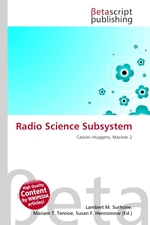Radio Science Subsystem
Lambert M. Surhone, Mariam T. Tennoe, Susan F. Henssonow
бумажная книга
High Quality Content by WIKIPEDIA articles! The Radio Science Subsystem (RSS) on a scientific spacecraft uses radio signals to probe a medium such as a planetary atmosphere. The spacecraft transmits a highly stable signal to ground stations, receives such a signal from ground stations, or both. Since the transmitted signal parameters are accurately known to the receiver, any changes to these parameters are attributable to the propagation medium or to the relative motion of the spacecraft and ground station. The RSS is usually not a separate instrument; its functions are usually "piggybacked" on the existing telecommunications subsystem. More advanced systems use multiple antennas with orthogonal polarizations. Radio science is commonly used to determine the gravity field of a moon or planet by observing Doppler shift. This requires a highly stable oscillator on the spacecraft, or more commonly a "2-way coherent" transponder that phase locks the transmitted signal frequency to a rational multiple of a received uplink signal that usually also carries spacecraft commands.
Данное издание не является оригинальным. Книга печатается по технологии принт-он-деманд после получения заказа.


